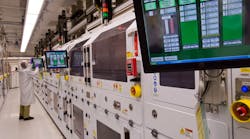2014 IW Best Plants Winner: At Boston Scientific Maple Grove, Lean Gets to the Heart of the Matter
All manufacturing companies focus on quality, and many can rightly claim that their products make a difference in people’s lives, but few have the intimate connection with end users that Boston Scientific has. At the company’s plant in "Medical Devices Alley" in Minnesota’s Twin Cities region, Boston Scientific’s Maple Grove facility designs and manufactures balloon catheters and stent delivery systems that ultimately will be surgically implanted into patients.
"All of our employees are aware that they’re not just making commodities like corn flakes or car tires, but products that will go into their bodies or their parents’ or loved ones’ bodies," explains Dale Hentges, vice president of operations at the Maple Grove plant. "Patient care is our number one guiding priority."
At A GlanceBoston Scientific Maple Grove, MN Employees: 1,615, non-union Total Square Footage: 515,000 Primary Product/Market: Medical devices (catheters, stents) Start-up Date: 1975 Achievements: Minnesota Governor’s Safety Award for the past 12 years; Shingo Silver Medallion, 2014; reduced plant cycle time by 48% over past three years |
Quality is very much a part of Boston Scientific’s DNA, and ever since 2000 the company’s standard business approach has been centered on its Strategic Quality Process (SQP). Both the SQP strategy and Boston Scientific’s lean initiatives began at the Maple Grove plant. They currently track 121 quality metrics at the plant, on such measures as effectiveness of corrective/preventative actions and number of defects passed to downstream internal manufacturing processes.
Boston Scientific, like other medical device manufacturers, is subject to close scrutiny by the U.S. Food and Drug Administration (FDA), and the company is required to maintain quality standards compliant with the FDA. To that end, "We have a very proactive relationship with the FDA, and we get their input very early in the new product development stages," explains Cory Rehnstrand, operations project manager.
New product development, in fact, is closely aligned with other areas of the company, with an R&D lab co-located on the Maple Grove campus with manufacturing, regulatory, clinical, sales and marketing groups. As with other processes, Boston Scientific has a very standardized product lifecycle process, and currently has 20 new products in development at the Maple Grove plant, according to Rehnstrand.
"Meaningful innovation is core to our operations," Hentges adds. "It’s one of our competitive advantages."
Boston Scientific structures its SQP processes on what it calls the four pillars, which are strategic goals of three to five years in duration. Currently, the company’s four pillars include: operational excellence, lean culture, accelerating growth and collaborative partnerships.
The company doesn’t necessarily "talk the talk" when it comes to its lean culture, frequently eschewing Japanese terms like "kaizens" in favor of "continuous improvement ideas," but it definitely follows through in execution. In 2014, Maple Grove employees submitted over 5,700 suggestions, with 3,000 of them implemented.
To cite just one project, a cross-functional engineering team reduced cycle time on a balloon catheter product by 20% while reducing cost of goods sold by 54%, yielding annual savings of $35 million. This project involved changes in welding technology, automating human inspection and a production line redesign.
This kind of team sharing is fostered by the introduction of a "collaboratory," an area where employees are encouraged to get together and come up with ideas that will help make Boston Scientific a leaner, smarter organization.




